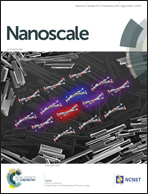Correlating anisotropy and disorder with the surface structure of platinum nanoparticles†
Abstract
Due to the competition between numerous physicochemical variables during formation and processing, platinum nanocatalysts typically contain a mixture of shapes, distributions of sizes, and a considerable degree of surface imperfection. Structural imperfection and sample polydispersivity are inevitable at scale, but accepting bulk and surface diversity as legitimate design features provides new opportunities for nanoparticle design. In recent years disorder and anisotropy have been embraced as useful design parameters but predicting the impact of uncontrollable imperfection a priori is challenging. In the present work we have created an ensemble of uniquely imperfect nanoparticles extracted from classical molecular dynamics trajectories and applied statistical filters to restrict the ensemble in ways that reflect common industrial design principles. We find that targeting different sizes and size distributions may be an effective way of promoting or suppressing internal disorder or crystallinity (as required), but the degree of anisotropy of the particle as a whole has a greater impact on the population of different types of surface ordering and active sites. These results indicate that tuning of disordered and anisotropic Pt nanoparticles is possible, but it is not as straightforward as geometrically ideal nanoparticles with a high degree of crystallinity. It is unlikely that a synthesis strategy could eliminate this diversity entirely, or ensure this type of structural complexity does not develop post-synthesis under operational conditions, but it may be possible to bias the formation of specific bulk structures and the surface anisotropy.



 Please wait while we load your content...
Please wait while we load your content...